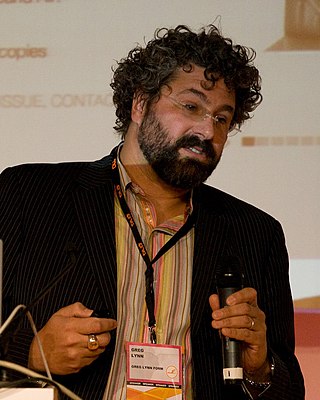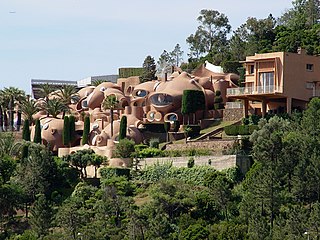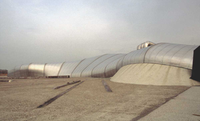
Future Systems was a London-based architectural and design practice, formerly headed by Directors Jan Kaplický and Amanda Levete.
The year 1997 in architecture involved some significant architectural events and new buildings.
The year 2002 in architecture involved some significant architectural events and new buildings.
The year 1978 in architecture involved some significant architectural events and new buildings.

Archigram was an avant-garde British architectural group whose unbuilt projects and media-savvy provocations "spawned the most influential architectural movement of the 1960's," according to Peter Cook, in the Princeton Architectural Press study Archigram (1999). Neofuturistic, anti-heroic, and pro-consumerist, the group drew inspiration from technology in order to create a new reality that was expressed through hypothetical projects, i.e., its buildings were never built, although the group did produce what the architectural historian Charles Jencks called "a series of monumental objects (one hesitates in calling them buildings since most of them moved, grew, flew, walked, burrowed or just sank under the water." The works of Archigram had a neofuturistic slant, influenced by Antonio Sant'Elia's works. Buckminster Fuller and Yona Friedman were also important sources of inspiration.

A blobject is a design product, often a brightly-coloured household object which has smooth curves and no sharp edges. The word is a portmanteau of "blob" and "object".

Sir Peter Cook is an English architect, lecturer and writer on architectural subjects. He was a founder of Archigram, and was knighted in 2007 by the Queen for his services to architecture and teaching. He is also a Royal Academician and a Commandeur de l'Ordre des Arts et des Lettres of the French Republic. His achievements with Archigram were recognised by the Royal Institute of British Architects in 2004, when the group was awarded the Royal Gold Medal.

Greg Lynn is an American architect, founder and owner of the Greg Lynn FORM office, a Full Professor at the Institute of Architecture at the University of Applied Arts Vienna and a professor at the UCLA School of the Arts and Architecture. He is CEO and co-founder of the Boston based robotics company Piaggio Fast Forward. He won a Golden Lion at the 2008 Venice Biennale of Architecture. In 2010 Lynn was named a fellow by United States Artists. He is a member of the board of trustees of the Canadian Centre for Architecture.

Biomorphism models artistic design elements on naturally occurring patterns or shapes reminiscent of nature and living organisms. Taken to its extreme it attempts to force naturally occurring shapes onto functional devices.

The Forum Building, is an architectural landmark in Barcelona designed by the Swiss architects Jacques Herzog and Pierre de Meuron.

Contemporary architecture is the architecture of the 21st century. No single style is dominant. Contemporary architects work in several different styles, from postmodernism, high-tech architecture and new references and interpretations of traditional architecture to highly conceptual forms and designs, resembling sculpture on an enormous scale. Some of these styles and approaches make use of very advanced technology and modern building materials, such as tube structures which allow construction of buildings that are taller, lighter and stronger than those in the 20th century, while others prioritize the use of natural and ecological materials like stone, wood and lime. One technology that is common to all forms of contemporary architecture is the use of new techniques of computer-aided design, which allow buildings to be designed and modeled on computers in three dimensions, and constructed with more precision and speed.

Deconstructivism is a postmodern architectural movement which appeared in the 1980s. It gives the impression of the fragmentation of the constructed building, commonly characterised by an absence of obvious harmony, continuity, or symmetry. Its name is a portmanteau of Constructivism and "Deconstruction", a form of semiotic analysis developed by the French philosopher Jacques Derrida. Architects whose work is often described as deconstructivist include Zaha Hadid, Peter Eisenman, Frank Gehry, Rem Koolhaas, Daniel Libeskind, Bernard Tschumi, and Coop Himmelb(l)au.

The Kunsthaus Graz, Grazer Kunsthaus, or Graz Art Museum was built as part of the European Capital of Culture celebrations in 2003 and has since become an architectural landmark in Graz, Austria. Its exhibition program specializes in contemporary art from the 1960s onwards.
Colin Fournier is co-architect with Peter Cook of the Kunsthaus Graz in Austria. Educated at the Architectural Association, Fournier was a founding member of Archigram.
The architecture of Israel has been influenced by the different architectural styles of those who have inhabited the country over time, sometimes modified to suit the local climate and landscape. Byzantine churches, Crusader castles, Islamic madrasas, Templer houses, Arab arches and minarets, Russian Orthodox onion domes, International Style modernist buildings, sculptural concrete Brutalist architecture, and glass-sided skyscrapers all are part of the architecture of Israel.

The BP Pedestrian Bridge, or simply BP Bridge, is a girder footbridge in the Loop community area of Chicago, United States. It spans Columbus Drive to connect Maggie Daley Park with Millennium Park, both parts of the larger Grant Park. Designed by Pritzker Prize-winning architect Frank Gehry and structurally engineered by Skidmore, Owings and Merrill, it opened along with the rest of Millennium Park on July 16, 2004. Gehry had been courted by the city to design the bridge and the neighboring Jay Pritzker Pavilion, and eventually agreed to do so after the Pritzker family funded the Pavilion.

Digital architecture refers to aspects of architecture that feature digital technologies or considers digital platforms as online spaces. The emerging field of digital architectures therefore applies to both classic architecture as well as the emerging study of social media technologies.

Atomic Age in design refers to the period roughly corresponding to 1940–1963, when concerns about nuclear war dominated Western society during the Cold War. Architecture, industrial design, commercial design, interior design, and fine arts were all influenced by the themes of atomic science, as well as the Space Age, which coincided with that period. Atomic Age design became popular and instantly recognizable, with a use of atomic motifs and space age symbols.

Palais Bulles is a large house in Théoule-sur-Mer, near Cannes, France, that was designed by the Hungarian architect Antti Lovag. It was built for the French industrialist Pierre Bernard, and later bought by the fashion designer Pierre Cardin as a holiday home.

The Aargauer Kunsthaus is a Swiss art museum founded in 1959, and located in Aarau. The museum collection includes Swiss art from the 18th century to the present day; and Naturama, a natural history collection.


































